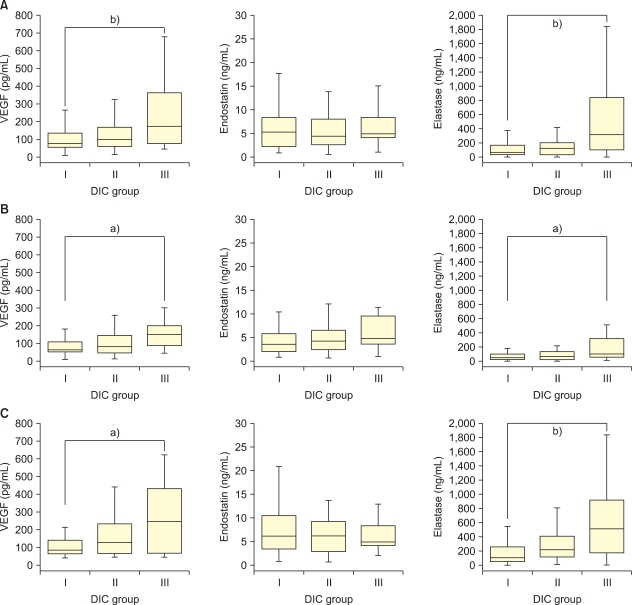Korean J Hematol.
2010 Mar;45(1):23-28. 10.5045/kjh.2010.45.1.23.
Usefulness of circulating vascular endothelial growth factor and neutrophil elastase as diagnostic markers of disseminated intravascular coagulation in non-cancer patients
- Affiliations
-
- 1Department of Laboratory Medicine, Seoul National University College of Medicine, Seoul, Korea. lukekhk@snu.ac.kr
- KMID: 2252079
- DOI: http://doi.org/10.5045/kjh.2010.45.1.23
Abstract
- BACKGROUND
Disseminated intravascular coagulation (DIC) is characterized by platelet and neutrophil activation. Platelets are the major source of circulating vascular endothelial growth factor (VEGF). Endostatin, an anti-angiogenic factor, is a fragment of collagen that is released from the extracellular matrix via the active cleavage of neutrophil elastase, thereby increasing the circulating level of endostatin. Hypercoagulable conditions such as DIC may induce the release of VEGF and neutrophil elastase from the platelets and neutrophils.
METHODS
We enrolled 240 patients who were clinically suspected of having DIC. Plasma levels of VEGF, endostatin, and neutrophil elastase were determined using commercial ELISA kits. Patients were diagnosed as having overt DIC if the cumulative International Society on Thrombosis and Haemostasis Subcommittee score was >5.
RESULTS
Overt DIC was diagnosed in 80 of the 240 patients. The circulating VEGF and neutrophil elastase levels gradually increased according to the severity of coagulopathy, as reflected by the DIC score. However, the circulating endostatin level did not change significantly according to the DIC score. We divided the patients into 2 groups: the non-cancer and cancer patient groups, to exclude the VEGF release from tumor tissues. Interestingly, in non-cancer patients, higher VEGF and neutrophil elastase levels were found to be significant diagnostic markers for overt DIC.
CONCLUSION
Our findings suggest that circulating VEGF and neutrophil elastase levels are laboratory markers reflecting coagulation activity. They are expected to be potential diagnostic markers of overt DIC, especially in non-cancer patients.
Keyword
MeSH Terms
-
Biomarkers
Blood Platelets
Collagen
Dacarbazine
Disseminated Intravascular Coagulation
Endostatins
Enzyme-Linked Immunosorbent Assay
Extracellular Matrix
Humans
Leukocyte Elastase
Neutrophil Activation
Neutrophils
Plasma
Thrombosis
Vascular Endothelial Growth Factor A
Collagen
Dacarbazine
Endostatins
Leukocyte Elastase
Vascular Endothelial Growth Factor A
Figure
Reference
-
1. Bick RL. Disseminated intravascular coagulation: objective clinical and laboratory diagnosis, treatment, and assessment of therapeutic response. Semin Thromb Hemost. 1996; 22:69–88. PMID: 8711492.
Article2. Taylor FB Jr., Toh CH, Hoots WK, Wada H, Levi M. Scientific Subcommittee on Disseminated Intravascular Coagulation (DIC) of the International Society on Thrombosis and Haemostasis (ISTH) Towards definition, clinical and laboratory criteria, and a scoring system for disseminated intravascular coagulation. Thromb Haemost. 2001; 86:1327–1330. PMID: 11816725.3. Folkman J, Broeder T, Palmblad J. Angiogenesis research: guidelines for translation to clinical application. Thromb Haemost. 2001; 86:23–33. PMID: 11487011.
Article4. Poon RT, Fan ST, Wong J. Clinical implications of circulating angiogenic factors in cancer patients. J Clin Oncol. 2001; 19:1207–1225. PMID: 11181687.
Article5. Nagashima M, Asano G, Yoshino S. Imbalance in production between vascular endothelial growth factor and endostatin in patients with rheumatoid arthritis. J Rheumatol. 2000; 27:2339–2342. PMID: 11036826.6. Song SH, Kim HK, Park MH, Cho HI. Neutrophil CD64 expression is associated with severity and prognosis of disseminated intravascular coagulation. Thromb Res. 2008; 121:499–507. PMID: 17597188.
Article7. O'Reilly MS, Boehm T, Shing Y, et al. Endostatin: an endogenous inhibitor of angiogenesis and tumor growth. Cell. 1997; 88:277–285. PMID: 9008168.8. Wen W, Moses MA, Wiederschain D, Arbiser JL, Folkman J. The generation of endostatin is mediated by elastase. Cancer Res. 1999; 59:6052–6056. PMID: 10626789.9. Miller JW, Adamis AP, Shima DT, et al. Vascular endothelial growth factor/vascular permeability factor is temporally and spatially correlated with ocular angiogenesis in a primate model. Am J Pathol. 1994; 145:574–584. PMID: 7521577.
Article10. Gunsilius E, Petzer A, Stockhammer G, et al. Thrombocytes are the major source for soluble vascular endothelial growth factor in peripheral blood. Oncology. 2000; 58:169–174. PMID: 10705245.
Article11. Feldman AL, Alexander HR Jr., Yang JC, et al. Prospective analysis of circulating endostatin levels in patients with renal cell carcinoma. Cancer. 2002; 95:1637–1643. PMID: 12365010.
Article
- Full Text Links
- Actions
-
Cited
- CITED
-
- Close
- Share
- Similar articles
-
- Spontaneous Subdural Hematoma Associated with Disseminated Intravascular Coagulation in Patient with Cancer
- Current Pathological and Laboratory Considerations in the Diagnosis of Disseminated Intravascular Coagulation
- Diagnostic efficacy of fibrinogen degradation product(FgDP) assay in disseminated intravascular coagulation
- Diagnostic efficacy of plasma D-dimer assay in evaluating disseminated intravascular coagulation: comparison with serum FDP assay based on ROC method
- Disseminated intravascular coagulation


